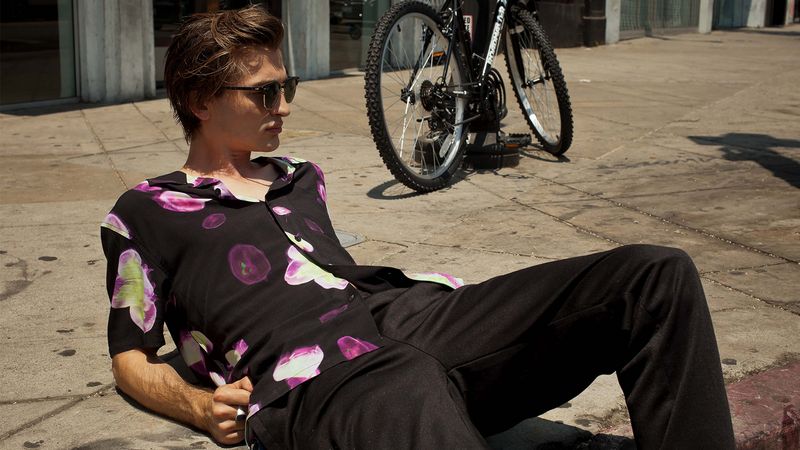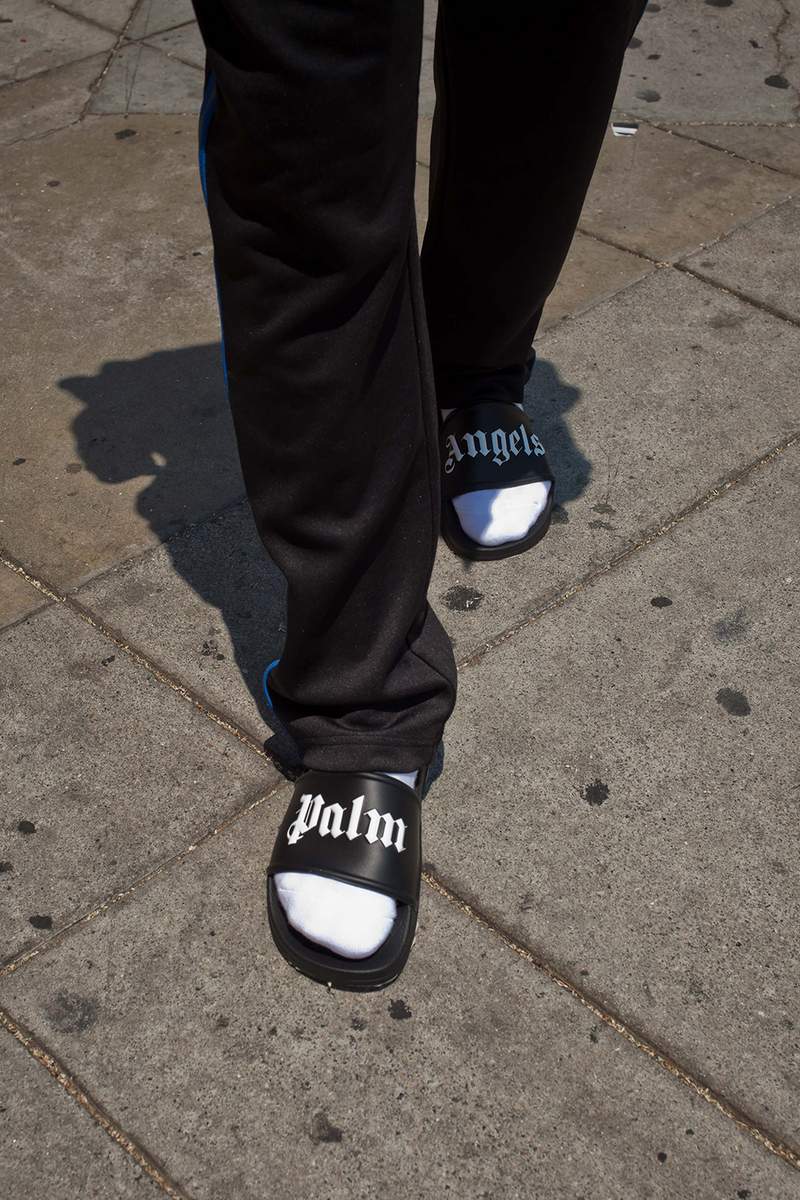THE JOURNAL

When it comes to global streetwear trends, all roads lead to one in Los Angeles.
For more than a century, Los Angeles has been the world capital of visual storytelling, unspooling new mythologies one panel at a time, 24 frames per second. Even within the city sprawl, the stories that Angelenos tell themselves, about themselves and about the world at large, come through images: on billboards, in murals, tags, graphic tees. In this city where self-mythology is a boom industry, exteriorisation is everything. Here, signalling is our native language, where the Bentleys are borrowed and the Lambos are on lease, branding, flexing, flash, are the local patois.
To find out what that looks and sounds like now, MR PORTER went right to the source, to the very centre of the Hypebeast-y heart of the city, to Fairfax Avenue, to see what the locals are wearing – and what the local brands are making. This corridor, formerly the centre of graffiti art in the late 1980s and early 1990s, and before that a late-night hangout for musicians, is the natural nexus for the main threads of American menswear these days, weaving together the best bits of rock’n’roll grunge, boxy skater silhouettes, an “eternal summer” surf vibe, and the sneaker culture that vaulted it all into the world of high fashion.

How did Fairfax become so cool? First, some history: it’s almost impossible to conceive of now, but before social media, before the internet even, when groups of like-minded individuals wanted to communicate, wanted to promote themselves or their squad, they created their own network, with their own in-speak and coding, and broadcasted it on the only platform that was then available for them: the city itself. This, in part, was the purpose of graffiti, which was so prevalent – and impressive – in LA in the 1980s that it prompted renowned documentarian Ms Agnès Varda to make a whole film about it: 1981’s Mural Murals. “In Los Angeles, you can see angels standing on the Pacific waters,” Ms Varda says in the film, a documentary about street art. “You can really see the movie stars... [But] I mostly saw walls, graffiti-covered walls as beautiful as paintings... living, breathing, seething walls... talking, wailing, murmuring walls.”


By the late 1980s, too, skateboarding, as a lifestyle, as an art form, had moved inland from the beach towns, onto the glitter-dusted and black gum-gobbed sidewalks of the city at large, bringing with it the anarchic, improvisational élan of skaters (as well as the surf-skatewear brand Stüssy), which merged with the community of graffiti artists already on the prowl there. On their own, both the graffiti artist and skater take cityscapes for what they are and, in different ways, respond – riffing, recontextualising, enriching or damaging their surroundings, depending on your point of view. Together, they transformed Los Angeles entirely.
At the same time, sneaker culture was on the rise, with sports stars revolutionising brand affiliation and consumer aspiration from the ground up with their signature shoes, making LA schoolyards into theatres for stunting, jacking and disrespectful steppings-on.

In the early 1990s, tolerant shop owners (of skate shops, sneaker shops and others hoping perhaps to benefit from the association with the cool new graffiti murals) and a talented crop of spray-can artists (some of whom, including Mear One and others of the CBS crew, were then students at Fairfax High School) made the Fairfax District, just southwest of Hollywood, a kind of new bohemia and a hotbed for the best work at the time. What was once a gathering place for Jewish grocers and emigres fleeing persecution in Europe – where Mr Christopher Isherwood and Mr Bertolt Brecht, among others, would head for a coffee klatch at The Farmer’s Market, at Canter’s Deli – became something of an outdoor gallery. Murals blossomed everywhere, some of them illicit but most on commission and fully permitted, executed, at times, with the authorities standing watch. Bringing the art inside, where it would join the establishment canon, was a logical next step. And, in 1997, the famous 01 Gallery on Melrose – which was said to be haunted by the spirits of Mr Rock Hudson and Ms Rita Hayworth, and where Mr Raymond Pettibon, and the punk band The Screamers had early shows – invited the great muralist Mear One to show his work. Merchandising the culture then became an inevitability.


One of the first streetwear brands to do it with some success was Conart, an artist-owned and operated outfit, and a direct precursor to Supreme with its tidy red relief logo on the front. For much of the early 1990s, the standard uniform of a tagger, of a skater, was a Conart tee, Dickies, and Chucks or Vans (a look that would not be at all out of place on Fairfax today). Conart begat Supreme; Stüssy, the new Stüssy. And, when, in the 2000s, sneaker culture broke into high fashion (beginning, perhaps, when the longtime LA-based Mr Rick Owens introduced his “dunks”, a fantastically decadent sneaker retailing above $1,000), a ceiling cracked. No longer did streetwear mean cheap tees and semi-disposable plimsolls. Now, basics were no longer so basic.
LA-based Fear of God, which recently introduced its own, fiercely beloved $1,500 sneaker, is perhaps exemplary of the generation that has come of age in this new reality. As self-taught creator and designer Mr Jerry Lorenzo described it in an interview with Complex in 2014, “It’s ‘street’ in the sense that that’s how it started, but it’s high end in the sense that I’m now using luxury fabrics, everything is made by the best sewers in LA, and everything is constructed to the highest-level quality.” Similarly Noon Goons, an LA brand created by Mr Kurt Narmore, has a hardcore “locals only” surf-punk vibe made luxury with the help of creative director Mr Sam Jarou, formerly of Comme des Garçons. Palm Angels celebrates the mythic nature of skate culture from the outside looking in, if you will. The line, based on a book of photographs by ex-Moncler art director Mr Francesco Ragazzi, is designed by Mr Ragazzi with those skaters in mind. And then there are brands like Rhude, by native Angeleno Mr Rhuigi Villaseñor, and FourTwoFour, by Mr Guillermo Andrade, which he sells out of his beloved shop on Fairfax, both of which feel very much on the bleeding edge of the zeitgeist and are coincidentally attracting a good deal of the city’s star power. Newly adopted Angeleno Mr LeBron James, the singer Miguel, and the rapper YG have been wearing a lot of Rhude’s designs of late. And YG gave a little love back to Fairfax a few weeks ago by performing an impromptu concert that shut down the street in front of FourTwoFour.


In order to illustrate what the whole thing actually looks and feels like, we asked a few guys we know from style and skate and music to take these wares for a spin around Fairfax. The skateboarder and filmmaker Mr Cal Travis Oaks has found the city a creative foil, making Super 8 films for brands like Dickies and Vans, along with his own feature-length skate films. And native Angeleno Mr Lucas Bin – a visual artist and up-and-coming musician – feels he comes to the world as naturally as he does skating and the guitar.


As we toured the city we found that, with each new iteration of streetwear, each new generation of muralists and skaters making their marks on the city, and entrepreneurial shop owners coming in to capitalise on the mainstreaming of their aesthetics, the city has continued to change. As Mr Jonathan Gold wrote, in a review of the restaurant Animal, “Fairfax Avenue, as it slumps from Canter’s Delicatessen toward the Silent Movie Theatre, is a testosterone-soaked patch of turf that might as well be called the Dude District, a strip of dive bars, gear shops and expensively retrofitted storefronts empty but for a rack or two of $175 T-shirts; art galleries less arty than the shop displaying carefully curated vitrines of baseball caps; rare-sneaker emporia where it is easier to find the DJ than a salesperson... The entire street, with the possible exception of a holdout Judaica store or two, is a living, drooling Thrillist entry...” And that was in 2008.

Not that the thrill is gone. As we wrapped our shoot on Fairfax, we ran into the rap-skate-Hypebeast icon Tyler, the Creator, frontman for the Odd Future group, who has a long history with Supreme and a shop of his own streetwear line on the street. In his tie-dyes, short shorts, mid-calf socks, dad shoes and a fluorescent hat, he looked like he’d walked right out of our shoot and into the bookstore Family. Greeting the clerk, and remarking on the heat, Tyler seemed for a moment a kindly mayor of Hypelandia.


What is to be said about graffiti, skating or streetwear today? It is hard not to wonder aloud as to what it means when something that was once cool, cloistered, even criminal, goes mainstream? Do the edges soften on an aesthetic, on a stance, a vibe, as it is embraced by the culture at large? Does the yearning for expression and community that gave rise to graffiti, for example, somehow suddenly vanish when it spills the bounds of its native subculture? Is skateboarding any less fulfilling for its pop-culture ubiquity?
Maybe it was Biggie’s death, on the corner of Fairfax and Wilshire, making the stretch of diners and 99 cent stores into a martyr’s walk. Maybe it was the graffiti coming indoors, as it were – inside the museums, as it did with the 2011 show Art in the Streets at MOCA, and Beyond the Streets, devised and produced by Mr Roger Gastman, on now in Downtown, preserving a once-renegade art in the amber of nostalgia. Maybe it was sneaker culture creeping into high fashion, blurring the lines between the two. Or maybe it was the internet, revving the cycles of reference and consumption to the red line. But streetwear and the cultures that spawned it are the culture now. What’s more, it may be the only tactile expression of the culture anymore. With music and movies and everything else going digital, poof! in the cloud, sneaker drops are this generation’s Harry Potter, comic books and Garbage Pail Kids, with teenagers lining up for a streetwear release the way they might have a record drop in years past.

In June of this year, the as-yet unreleased scripted comedy Like And Subscribe (a show about YouTube culture, to be released on a different platform), put up what was termed an influencer-only mural on Melrose Avenue, once home of the greatest works of spray-can art, as a kind of guerilla promotion. A bouncer on site was instructed to only permit power users of social media with followings in the tens of thousands in front of the mural – presumably to take selfies. Not exactly one of the prophesied signs of coming apocalypse, but augury nonetheless.

But, silly stunts aside, isn’t it great when something that is actually cool – spray-can art, skateboarding, hip-hop – goes mass? “Graffiti and street art have become their own cultures and spawned their own subcultures,” Mr Gastman says. “I can attribute it to people like us growing up. Thankfully, we are decision makers, in places of power, and shifts have been made in all forms of life and expression as the new guard takes over.” Cycles refresh. The torch remains lit.

Which is a novel proposition, especially in Los Angeles, a place that is not exactly famous for its cultural memory. In a town that would rather print the legend, stories of the past can get a little fuzzy, if not altogether pulped and replanted to seed new myths, and newer ones still. But, it turns out, the forgotten history we are proverbially doomed to repeat is pretty rad.